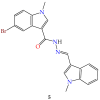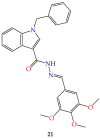Acylhydrazones and Their Biological Activity: A Review
- PMID: 36557851
- PMCID: PMC9783609
- DOI: 10.3390/molecules27248719
Acylhydrazones and Their Biological Activity: A Review
Abstract
Due to the structure of acylhydrazones both by the pharmacophore -CO-NH-N= group and by the different substituents present in the molecules of compounds of this class, various pharmacological activities were reported, including antitumor, antimicrobial, antiviral, antiparasitic, anti-inflammatory, immunomodulatory, antiedematous, antiglaucomatous, antidiabetic, antioxidant, and actions on the central nervous system and on the cardiovascular system. This fragment is found in the structure of several drugs used in the therapy of some diseases that are at the top of public health problems, like microbial infections and cardiovascular diseases. Moreover, the acylhydrazone moiety is present in the structure of some compounds with possible applications in the treatment of other different pathologies, such as schizophrenia, Parkinson's disease, Alzheimer's disease, and Huntington's disease. Considering these aspects, we consider that a study of the literature data regarding the structural and biological properties of these compounds is useful.
Keywords: acylhydrazone; anti-inflammatory; antimicrobial; antioxidant; antiparasitic; antiviral; cytotoxic; intermediates; properties; synthesis.
Conflict of interest statement
The authors declare no conflict of interest.
Figures




































































Similar articles
-
Society for Neuroscience--36th Annual Meeting: Treatments for pain and Parkinson's, Huntington's and Alzheimer's diseases.IDrugs. 2006 Dec;9(12):819-22. IDrugs. 2006. PMID: 17139564 No abstract available.
-
Phytochemical and biological activities of Pinus halepensis mill., and their ethnomedicinal use.J Ethnopharmacol. 2021 Mar 25;268:113661. doi: 10.1016/j.jep.2020.113661. Epub 2020 Dec 1. J Ethnopharmacol. 2021. PMID: 33276057 Review.
-
Human brain D1 and D2 dopamine receptors in schizophrenia, Alzheimer's, Parkinson's, and Huntington's diseases.Neuropsychopharmacology. 1987 Dec;1(1):5-15. doi: 10.1016/0893-133x(87)90004-2. Neuropsychopharmacology. 1987. PMID: 2908095
-
1,3-thiazole Derivatives: A Scaffold with Considerable Potential in the Treatment of Neurodegenerative Diseases.Curr Top Med Chem. 2023;23(23):2185-2196. doi: 10.2174/1568026623666230719124850. Curr Top Med Chem. 2023. PMID: 37469159 Review.
-
The Medicinal Chemistry of Natural and Semisynthetic Compounds against Parkinson's and Huntington's Diseases.ACS Chem Neurosci. 2017 Nov 15;8(11):2356-2368. doi: 10.1021/acschemneuro.7b00283. Epub 2017 Sep 15. ACS Chem Neurosci. 2017. PMID: 28862431 Review.
Cited by
-
Synthesis of extended fluorinated tripeptides based on the tetrahydropyridazine scaffold.Beilstein J Org Chem. 2024 Dec 4;20:3174-3181. doi: 10.3762/bjoc.20.262. eCollection 2024. Beilstein J Org Chem. 2024. PMID: 39669444 Free PMC article.
-
Synthesis and structure of (E)-3,4,5-trihy-droxy-N'-(3,4,5-tri-meth-oxy-benzyl-idene)benzohydrazide monohydrate.Acta Crystallogr E Crystallogr Commun. 2025 May 13;81(Pt 6):497-500. doi: 10.1107/S2056989025004001. eCollection 2025 Jun 1. Acta Crystallogr E Crystallogr Commun. 2025. PMID: 40487702 Free PMC article.
-
Design, Synthesis, and Biological Evaluation of N-Acylhydrazones and Their Activity Against Leishmania amazonensis Promastigotes.Microorganisms. 2025 Jul 2;13(7):1563. doi: 10.3390/microorganisms13071563. Microorganisms. 2025. PMID: 40732071 Free PMC article.
-
Identification of N-Acyl Hydrazones as New Non-Zinc-Binding MMP-13 Inhibitors by Structure-Based Virtual Screening Studies and Chemical Optimization.Int J Mol Sci. 2023 Jul 4;24(13):11098. doi: 10.3390/ijms241311098. Int J Mol Sci. 2023. PMID: 37446276 Free PMC article.
-
Analogs of the Catechol Derivative Dynasore Inhibit HIV-1 Ribonuclease H, SARS-CoV-2 nsp14 Exoribonuclease, and Virus Replication.Viruses. 2023 Jul 13;15(7):1539. doi: 10.3390/v15071539. Viruses. 2023. PMID: 37515225 Free PMC article.
References
-
- Gao P., Wei Y. Efficient oxidative cyclization of N-acylhydrazones for the synthesis of 2,5-disubstituted 1,3,4-oxadiazoles using t-BuOI under neutral conditions. Heterocycl. Commun. 2013;19:113–119. doi: 10.1515/hc-2012-0179. - DOI
-
- Başpınar Küçük H., Alhonaish A., Yıldız T., Güzel M. An efficient approach to access 2,5-disubstituted 1,3,4-oxadiazoles by oxidation of 2-arenoxybenzaldehyde N- acyl hydrazones with molecular iodine. ChemistrySelect. 2022;7:e202201391. doi: 10.1002/slct.202201391. - DOI
-
- Pelipko V.V., Gomonov K.A. Formation of five- and six-membered nitrogen-containing heterocycles on the basis of hydrazones derived from α-dicarbonyl compounds (microreview) Chem. Heterocycl. Compd. 2021;57:624–626. doi: 10.1007/s10593-021-02958-8. - DOI
-
- Morjan R.Y., Mkadmh A.M., Beadham I., Elmanama A.A., Mattar M.R., Raftery J., Pritchard R.G., Awadallah A.M., Gardiner J.M. Antibacterial activities of novel nicotinic acid hydrazides and their conversion into N-acetyl-1,3,4-oxadiazoles. Bioorganic Med. Chem. Lett. 2014;24:5796–5800. doi: 10.1016/j.bmcl.2014.10.029. - DOI - PubMed
-
- Ţînţaş M.L., Diac A.P., Soran A., Terec A., Grosu I., Bogdan E. Structural characterization of new 2-aryl-5-phenyl-1,3,4-oxadiazin-6-ones and their N-aroylhydrazone precursors. J. Mol. Struct. 2014;1058:106–113. doi: 10.1016/j.molstruc.2013.11.005. - DOI
Publication types
MeSH terms
Substances
LinkOut - more resources
Full Text Sources
Medical

